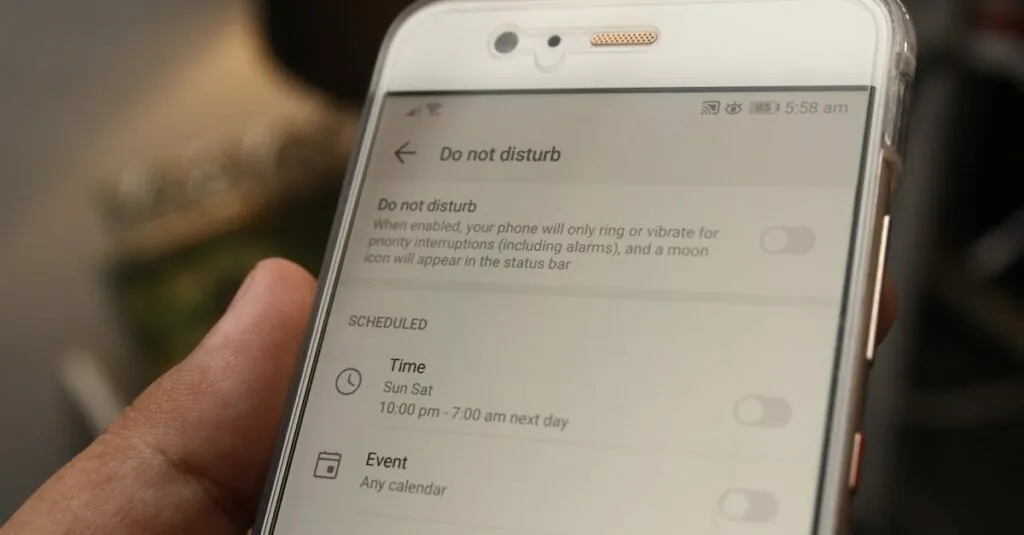In a world where smartphones have become extensions of ourselves, mobile control apps are the unsung heroes of modern convenience. Imagine having the power to manage your devices from the palm of your hand, like a tech-savvy wizard casting spells with a flick of a finger. Whether it’s turning off the lights or adjusting the thermostat, these apps make life smoother than a well-oiled machine.
Table of Contents
ToggleOverview of Mobile Control Apps
Mobile control apps significantly enhance the way users interact with their devices. These applications simplify tasks, making daily life more efficient and convenient.
Definition and Purpose
Mobile control apps allow users to manage smart devices from their smartphones or tablets. They include functionalities like adjusting lighting, controlling thermostats, and monitoring security systems. Users benefit from the ability to automate processes. Automation saves time and reduces the need for manual intervention. By consolidating control, these apps help users enjoy seamless device management across different platforms.
Importance in Today’s Digital World
Mobile control apps hold essential roles in modern technology usage. They enable users to integrate various smart devices into one cohesive system. Such integration promotes a more streamlined lifestyle, enhancing overall comfort and security. Businesses also recognize the value of mobile control apps for improving efficiency. According to recent statistics, 60% of users prefer managing their devices through mobile apps compared to traditional methods. Adoption of these apps continues to grow, reflecting the increasing demand for smarter living solutions.
Features of Mobile Control Apps
Mobile control apps offer a range of features that enhance user experience while managing smart devices easily. They allow for streamlined interactions, making technological management intuitive.
User Interface and Usability
A clean interface contributes to effective navigation within mobile control apps. Users often appreciate straightforward layouts that minimize confusion. Intuitive design elements ensure that even non-tech-savvy individuals can use the apps without difficulty. Quick access buttons provide immediate control over devices, enhancing efficiency. Clear instructions for functionalities simplify the learning process. Transparent feedback during interactions assures users of successful operations.
Security and Privacy Measures
Security remains a top priority in mobile control apps. Many applications utilize encryption protocols to protect users’ data. Regular updates further ensure that vulnerabilities are addressed promptly. Users can often set authentication features like biometric logins or PIN codes for added safety. Data privacy policies provide transparency regarding the information collected and how it’s used. Robust measures protect against unauthorized access, fostering trust among users.
Types of Mobile Control Apps
Mobile control apps encompass a variety of functionalities tailored to enhance user experience with smart devices. They fall into several categories, each serving specific needs.
Remote Control Applications
Remote control applications enable users to manage devices from a distance. These apps provide access to TVs, streaming devices, and other electronics via smartphones or tablets. Users can adjust volume settings and change channels or control playback without needing a physical remote. According to research, 70% of consumers utilize remote control applications for television and multimedia devices, reinforcing their popularity in modern households.
Home Automation Apps
Home automation apps allow users to control multiple smart home devices seamlessly. These apps enable management of lighting, heating, and security systems through a single interface. With features like scheduling and scene creation, users customize their environments for different times of day. The increasing adoption of smart home technology has made these apps essential, with forecasts indicating nearly 30% annual growth in home automation market shares.
Device Management Software
Device management software focuses on overseeing and organizing various connected devices. Users can monitor performance, update firmware, and troubleshoot issues directly through these applications. Such software serves both personal and professional uses, streamlining management for IT departments in businesses. Research indicates that 65% of organizations rely on device management solutions to enhance operational efficiency and increase security across devices.
Pros and Cons of Mobile Control Apps
Mobile control apps offer various benefits and drawbacks that impact usability and functionality.
Advantages
Enhanced convenience stands out as a primary benefit of mobile control apps. These applications allow users to manage various smart devices directly from their smartphones or tablets. Increased efficiency occurs through automation features, which minimize time spent on repetitive tasks. User-friendly interfaces facilitate quick navigation, making these apps accessible even to those less tech-savvy. Statistics reveal that 60% of consumers prefer using mobile apps over traditional methods for device management. Furthermore, improved security measures, including encryption protocols and regular updates, ensure user data remains protected. Finally, integration of multiple devices creates a streamlined experience that enhances overall home management.
Disadvantages
Despite their advantages, mobile control apps present certain challenges. Dependency on internet connectivity can hinder app functionality, as poor or unstable connections affect performance. Privacy concerns arise when users share personal data with various applications, creating potential security risks. Some apps may involve a steep learning curve, deterring less experienced users from fully exploiting the available features. Additionally, compatibility issues can occur, as not all devices work seamlessly with every app. Costs associated with purchasing premium versions or necessary subscriptions can also deter users. Finally, frequent updates might disrupt app usability, leading to frustration for users seeking consistency.
Popular Mobile Control Apps on the Market
Numerous mobile control apps are available, each designed to cater to different user needs and preferences. These applications enhance convenience and efficiency in managing smart devices.
Comparison of Top Applications
Comparing top mobile control apps reveals their unique features and functionalities. For instance, Google Home excels in integrating various smart devices, offering seamless voice control capabilities. Amazon Alexa provides extensive compatibility with third-party products, creating a comprehensive ecosystem. Apple HomeKit stands out for its strong security measures and user-friendly interface. SmartThings by Samsung offers robust automation features, allowing users to create customized routines. Each app supports multiple device types, enabling users to choose based on specific needs.
User Reviews and Feedback
User feedback highlights the strengths and weaknesses of these mobile control apps. Many users appreciate Google Home for its intuitive design and voice command accuracy. Reviews often praise Amazon Alexa for its extensive device compatibility, making it a top choice among smart home enthusiasts. Users frequently express concerns about Apple HomeKit, pointing out occasional compatibility issues with non-Apple devices. Performance of SmartThings receives mixed reviews, with some users noting its complex setup. Overall, user feedback indicates a strong preference for apps that offer a balance of ease and functionality.
Mobile control apps are transforming how users interact with their smart devices. By simplifying tasks and promoting automation, these applications enhance daily convenience and efficiency. The growing preference for mobile management underscores a shift towards smarter living solutions that prioritize user experience.
As technology continues to evolve, the demand for intuitive and secure mobile control apps will only increase. With features designed for both tech-savvy individuals and novices, these apps are paving the way for a more connected lifestyle. Embracing mobile control apps not only streamlines home management but also enhances comfort and security in everyday life.





